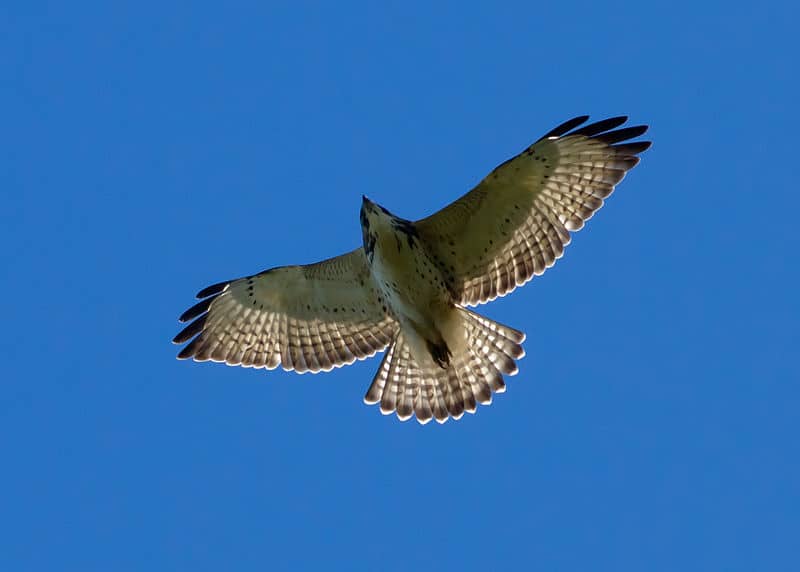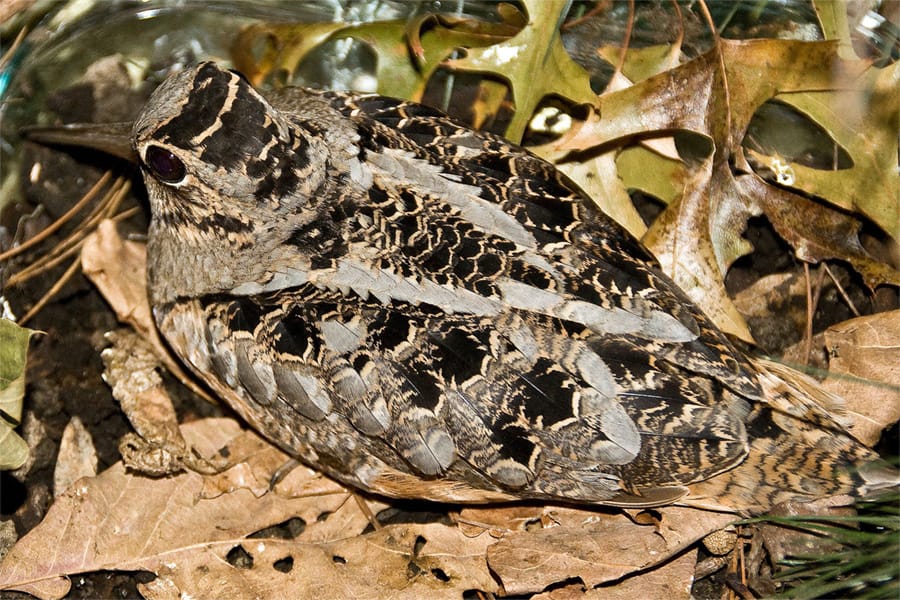Here in Wyoming, known both to Indian and white man as the “edge of the plains,” the ground bumps and bulges, molding itself into mounds of sparse short grasses and spiny cacti. Our raft winds its way between these hummocks, through canyons of naked rock, layered with gradations of red, and brown, and gray, past ancient, gnarled cottonwoods clinging to the water’s edge. The group is swept away by the North Platte River.
Part of a National Audubon field trip, we are forty-two strong, traveling in the land of John Wayne and Bonanza, of fourth-grade history classes, and of “Let’s head ’em off at the pass” legend. It is an arid land, only four inches of rainfall away from true desert conditions: a land of huge wide open spaces where the buffalo used to roam, where the deer and the antelope play, and where it takes one hundred acres to support a single steer; a land where those living on the North Platte own it—or at least the cubic gallons of water coursing by at any given moment: a land where a four-foot strip bordering the river appears as lush and damp as a New England forest. Yet only inches away, the temperature soars up more than 25 degrees. sagebrush whisks past prickly pear cacti., ant hills grow as tall as sand castles, and bare feet blister in the dry, brittle sand.
We travel in two groups of four rafts each, six to a raft. There is a Disneyesque quality to our motion, for we seem suspended in a timeless paradise created solely for our pleasure. Big-horned sheep magically appear in postcard poses atop craggy rock faces. Just around the bend, through the low-hanging branches, a doe raises her head to meet twelve staring eyes head on.
But this is not the manicured precision of playland’s river country or of the television tube. This world is real. Here, we drape ourselves over the raft’s burning rubber walls. Our dangling feet turn red in the icy water. Our faces, despite protection from zinc oxide and wide-brimmed hats, fry twice, from the sun which beats down and then is reflected skyward once again. One must squint from the water’s glare, as trout—rainbows, speckled, and cutthroat—dart beneath the boat, for the North Platte is a blue-ribbon stream, a survivor in a fast diminishing class. The fishermen among us cast over the side, and again I must pinch myself to remember: This is real.
More than seventy-five bald eagles live along the precious rivers and streams of Wyoming, or so the state naturalists say. I have seen three of them—though not owing alone to my own observational skill, for the wise novice naturalist lives by the well-known scientific law: The chances of seeing something anything— increase in direct proportion to the number of eyes available at any given moment. Properly controlled, this truism is a major advantage in that unique phenomenon, the “group field trip.”
The last five minutes—or perhaps it is sixty—have been particularly quiet, the relentless stillness of mid-afternoon. Leaving behind several miles of long, narrow river, we pick up speed. The raft whips around a sweeping bend, revealing a vista heavy with low-hung branches, tangled bushes, and tall, straggly trees.
Stimulated by the sudden change in perspective, one, then two fellow passengers stand. Their binoculars deliberately scan the approaching shoreline. Mine remain untouched, carelessly draped around my neck, my feet languidly splashing over the hot silver sides of the raft. An oar thumps in its sturdy oarlock. I have nothing to do but squint, and think. There is definitely some thing odd about those trees on the horizon. The low-hanging branches seem awfully gnarled, the trees too generously knotted. Hushed, guttural, gurgling sounds emanate from the restless humans aboard. I have seen the symptoms before— they have picked up a scent.
We are nearly past a spot where the water surges into a pocket beneath the brambles. A large, dark blotch sits atop a cluttered mound of growth. Someone raises an arm—and the word “eagle” is muttered quietly, reverentially, and without doubt. There is a pause, a fraction of a space of disbelief.
Split seconds later, a raucous bumping and grinding envelops the rubber raft. It bobs and twists, bumps and grinds, as binoculars are passed to and fro, cameras appear from watertight containers, and six civilized travelers vie for better viewing angles. Then, complete stillness.
By this time, magnifying aids are irrelevant. With the naked eye one cannot miss the curled yellow talons, the black, pointed nails at their tips, the thick, curved bill, the piercing stare. Not ten feet away, the eagle is a fierce, proud creature, mighty in its motionlessness. Its only perceivable reaction to our presence: the deliberate turning of its head as huge yellow eyes follow the crazy patchwork of circles we make in the currents. We have come close enough to notice the minute details, close enough to realize that which we do not know. It is an eagle. surely—but precisely what kind’?
Our boatman, expert at the near miss, hauls with all his strength, holding the raft stationary and as close as possible. craning his neck, constantly straining to work the oars—all the while muttering, “Jeez. I’m glad I didn’t miss this.” Chances are he has seen all Wyoming bald eagles two times over. Still, even he remains unsure.
Our specimen is an over-all grayish-brown color, perhaps with a suggestion of white scattered about. The first report arrives confidently from the rear of the raft, “It appears to have a band of white plumage at the base of the tail.”
“That would make it an immature golden, according to this,” confirms the keeper of the field guide. “But see it’s got a brownish bill.”
“It’s got to be an immature—of one or the other,” volunteers an other. Exasperated. I demand the book. The variables are just too confusing as I try to keep my mental lists straight: immature golden—wrist of white feathers at base of primaries, ringtail plumage at base of the tail; immature bald— uniform gray undertail. brownish bill, pale yellow eyes, and lemon colored feet; mature golden— dark brown eyes, over-all brownish color.
Nearly convinced that the evidence points to mature golden, the boatman works the oars in pursuit of further proof—and the debate rages on. “I read that you can compare the fullness of the leg feathers.” I am pouring over the field guide, fidgety at the expense of neglecting the living model. But this last clue is too much to handle. Closing the book with a thud, I wonder aloud, “Yes, but compared to what exactly?”
“Well, the feathers on the golden should go further down, I think,” comes the response.
“Yes, but further down than what? We’d need eagles of both kinds in all stages of maturity lined up side by side for that method to work!” It is too exasperating.
The river tugs at our side with determination. There is not a moment to lose. Breaking the spell of eyeball-to-eyeball contact, my head rolls round and round, relieving tension, perusing the highest treetops. And there, at the top of the canopy, the final clues to all our questions: Two more hulking, black-bodied, white-headed creatures have, in their turn, made our small human society the center of their observable universe. They are, unmistakably a pair of mature bald eagles.
For the past twenty-odd minutes we have been studying a bald eagle in transition, an adolescent. The proximity of the watchful adult pair is perhaps no accident. As I pass the field guide back to its owner, my eye reluctantly meets her gaze. The same thought has occurred to her. To be the object of an eagle’s concentration is terrifying.
In our hearts there is a primal yearning— to see any of these three statuesque creatures fly, or fish, or preen, to observe any small behavior at all. But another boat approaches from the rear. Atop the closest disheveled perch, our hypnotist stands frozen solid, nearly out of sight. Another curve in the river looms near, and foliage obscures the adult birds. The raft’s empty back end tips high out of the water, while the bow is heavy with the bodies of enthusiastic birders.
As we round the bend, a sudden flurry of movement occurs in the distance. “Oh, look, he’s gonna fly!” A crouch, then a burst from powerful, feathered legs, and the immature bald is off, arching out over the river, a black silhouette vanishing into the horizon. We settle back into our private silences once again, dabbling in the water, spotting a family of mergansers here, a dipper there, casting for trout. The gyrating rubber floor is finally quiet. But the moment remains. The view, the birds, the brief glimpse of unbridled wildness—all are gifts to remember for a lifetime.




